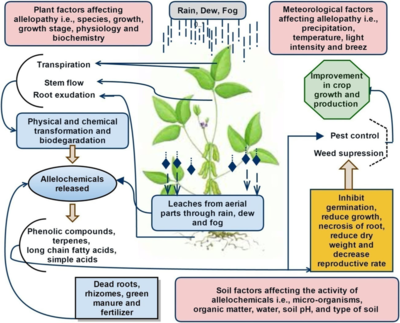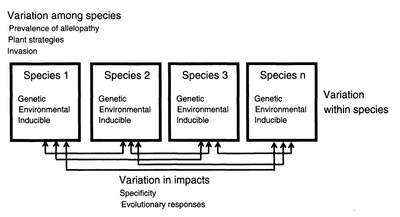Allelopathy
Allelopathy (Gr: allelon (of each other) and pathos (to suffer)) is broadly defined as any chemical-mediated interaction among plants, though it is typically thought of as a mechanism of inhibition. [1] The term allelopathy was coined in 1937 by Hans Molisch to refer to any biological interactions between all types of plants, but was refined by Rice in 1974 as “any direct or indirect harmful effect by one plant (including microorganisms) on another through production of chemical compounds that escape into the environment.” [2]

Mechanism
Allelopathy is caused by the release of secondary compounds into the soil. Secondary compounds include plant metabolites like auxin and cytokinin, plant metabolites like flavonoids as well as antifeedants like emodin, and allow plants to behave in numerous ways.[3] Flavonoids, for example, act as a signaling agent and chelation agent while also playing a role in plant defense. The effect of allelopathy depends on a chemical being added to the environment, distinguishing this form of interference from competition[1].
Evolution
Generally, the secondary metabolites that act as allelochemicals serve other purposes in the plants function; natural selection should favor secondary metabolites with multiple functions because they protect the plants against a variety of unpredictable biotic and abiotic environments.[4] Allelopathy may also drive evolution in the neighbors of allelopathic plants as well: one study found that individuals grown from seeds of parents that have survived exposure to allelochemicals in Centaurea stoebe have exhibited much higher resistance to the general competitive effects of Centaurea, the root exudates from Centaurea, and to a chemical specific to the root exudates of Centaurea ( ± )-catechin relative to other native species that have not previously encountered Centaurea maculosa[5].
Ecology

Chemicals produced by plants have strong effects on ecosystem properties, altering rhizosphere chemistry, chelating metals, altering soil community interactions, and shifting plant community interactions [6].
Role in Biological Invasion
A comparison of exotic plant species that are highly invasive in North America with exotics that are widespread, but non-invasive revealed that the invasive plants were more likely to have secondary compounds that have not been reported from North American native plants.[7] According to the Novel Weapons Hypothesis, invasive species possess novel weapons in the form of chemicals that suppress the growth of neighboring plants in an alien environment, allowing them to spread and form their own monocultures. In the native range, such species grow normally in association with other plants. Seemingly, the native plants’ tolerance evolves toward chemicals or the so-called novel weapons on account of their long association. [8]
References
1. Rice, E. L. ALLELOPATHY - AN OVERVIEW. 2.
2. Amb, M. K. & Ahluwalia, A. S. Allelopathy: Potential Role to Achieve New Milestones in Rice Cultivation. Rice Science 23, 165–183 (2016).
3. Metlen, K. L., Aschehoug, E. T. & Callaway, R. M. Plant behavioural ecology: dynamic plasticity in secondary metabolites. Plant, Cell & Environment 32, 641–653 (2009).
4. Izhaki, I. Emodin - a secondary metabolite with multiple ecological functions in higher plants. New Phytol 155, 205–217 (2002).
5. Callaway, R. M. Natural selection for resistance to the allelopathic effects of invasive plants. natural selection 8 (2005).
6. Inderjit, Wardle, D. A., Karban, R. & Callaway, R. M. The ecosystem and evolutionary contexts of allelopathy. Trends in Ecology & Evolution 26, 655–662 (2011).
7. Cappuccino, N. & Arnason, J. T. Novel chemistry of invasive exotic plants. Biol. Lett. 2, 189–193 (2006).
8. Batish, D., Singh, H., Kaur, S. & Kohli, R. Novel weapon hypothesis for the successful establishment of invasive plants in alien environments: A critical appraisal. in Invasive Plant Ecology 19–28 (CRC Press, 2013). doi:10.1201/b13865-4.